JQ Magazine Seeks Writers for Spring 2013!
As we slide into spring, JETAA New York’s JQ magazine continues to provide content with an ever-expanding array of articles, interviews and features (see our recent stories here). We’re now looking for new writers, including recent returnees and JET vets, from all JETAA chapters worldwide for posting stories via our host at the global JET alumni resource site JETwit.com. (Scribes are also encouraged to join the JET Alumni Writers group on LinkedIn.)
Below are story ideas grouped by JET participants and alumni (JET World) and those more on Japanese culture (Japan World). And if you’re a JET or JETWit contributor from anywhere in the world with a story idea of your own, let us know!
Click “Read More” below for our spring 2013 ideas pitch package, and contact JQ editor Justin Tedaldi (magazine [at] jetaany [dot] org) to sign up for stories.
JQ Magazine: Book Review – ‘Yoko Ono: Collector of Skies’
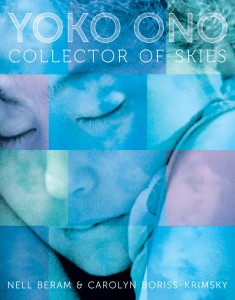
“The book’s release is timed to coincide with Ono’s 80th birthday on February 18, and provides readers snippets of info on some tumultuous periods during her lifetime.” (Amulet Books)
By Rashaad Jorden (Yamagata-ken, 2008-2010) for JQ magazine. Rashaad worked at four elementary schools and three junior high schools on JET, and taught a weekly conversion class in Haguro (his village) to adults. He completed the Tokyo Marathon in 2010, and was also a member of a taiko group in Haguro.
“Everybody knows her name, but nobody knows what she does.”
That line—uttered by the most famous of her three husbands—could accurately sum up Yoko Ono for a long time. But that shouldn’t be the case. Fortunately, thanks to a new book co-written by Nell Beram and Carolyn Boriss-Krimsky, readers have insight into this remarkable woman’s life.
Yoko Ono: Collector of Skies—so titled because Ono has always looked to the sky for inspiration—delves into the life of the famous avant-garde artist and musician, from her childhood in Japan and the U.S. to her chart-topping success in her seventies. The book’s release is timed to coincide with Ono’s 80th birthday on February 18, and provides readers snippets of info on some tumultuous periods during her lifetime.
Ono’s journey is presented in an easy-to-read format geared toward young adults. Unlike many other biographies, where all the photographs tend to be lumped together in a couple of sections, the photos in Collector of Skies are spread throughout the book, and they range from one in which Ono is wearing a kimono at the age of two to another taken at the inaugural lighting of the Imagine Peace Tower in Reykjavik in 2007. The authors also use quotes from Ono to expound upon certain periods and moments of her life.
Of course, any story about Yoko Ono has to make heavy mention of her relationship with John Lennon, and the middle of the book is largely devoted to her life with the former Beatle. While Collector of Skies might not reveal anything earth shattering for hardcore Lennon and Beatles fans, younger readers (or those unfamiliar with the Beatles) will learn not just the real story of the group’s breakup, but more importantly, the duo’s activism.
JQ Magazine: JQ&A with Bruce Feiler on ‘The Secrets of Happy Families’
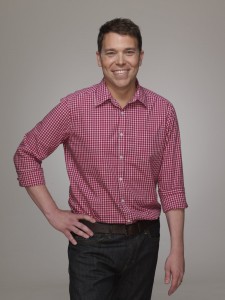
“One big idea in my book is that families should adapt all the time. The single best thing we’ve done is to add a weekly family meeting. We ask three questions, based on a popular program called ‘agile families.’ And no surprise: that idea was born in Japan in the culture of real-time change.” (Courtesy of HarperCollins Publishers)
By Sharona Moskowitz (Fukuoka-ken, 2000-01) for JQ magazine. Sharona is interested in fresh, new voices in fiction and creative nonfiction.
New York Times bestselling author and columnist Bruce Feiler (Tochigi-ken, 1987-88) has written a range of books dealing with topics as varied as life in Japan (depicted in 1991’s Learning to Bow), religion, and his own diagnosis with cancer.
His latest book, The Secrets of Happy Families, is a playbook for today’s family with tips and advice for increasing overall happiness and strengthening the family unit. Unlike other family-related books, Feiler does not advocate one particular method or philosophy over another; rather, he has done a thorough investigation of what happy families have in common and offers readers a slice of the pie.
In this exclusive interview, Feiler shares how his experience in Japan has given him insight into family life across cultures, as well as his take on the modern family’s trials and tribulations.
It seems the book market is already glutted with all sorts of self-help books about families. What sets your book apart and why do you feel that it is particularly timely?
In many ways, I was motivated by the deluge of self-help books. They’re boring, tried, and out of fresh ideas. As a parent, I was completely frustrated and had tons of questions about how to make my family function more effectively, and the only books out there were from “family experts.” Meanwhile, in every other arena of contemporary life—from Silicon Valley to elite peace negotiators, from championship sports teams to the Green Berets—there are proven new ways to make teams and groups run more smoothly. I wanted to know what those people were doing with their own families, then test their ideas with mine. Not every idea worked. That’s why I put over 200 new ones in the book, because what clicks with your family may be different from what clicked with mine. But my hope is that if you take three ideas, you’ll have a happier family in a week.
In the chapter about the agile manifesto, you talk about the importance of “being part of the family team.” In writing about the importance of teamwork within the family, were you inspired at all by your experience in Japan, a culture which valorizes the group above all else?
I think it may be more the other way around, in that I was attracted to Japan because I’ve always been interested in tight groups and well-run teams. At the time I lived in Japan, in the late 1980s, Americans still believed that the individual mattered above all else. But one thing we’ve learned from the Internet is that we all have a natural inclination toward groups, social networks, and other gatherings of people. The first generation of happiness research has shown us that relationships matter above all else. Happiness is other people. And the people who matter most to us are our family. Yet there have been almost no books that tell us how to do that.
Are there other cultural practices you observed in your time in Japan which you believe could benefit American families?
One I learned while in Japan is that being part of a group doesn’t just happen. Japanese schools, in particular, work on it. I remember a school trip I went on where classes were divided into small groups. The number one rule was, don’t be late. The number two rule was, only one person in each group was allowed to have a watch. Guess what! You better stick together. Having a close family doesn’t just happen, either—you have to work on it. Fortunately, there are lots of new ideas out there to do that, which I’ve tried to gather.
JQ Magazine: JQ&A with Takashi Ikezawa of Resobox Japanese Art Gallery
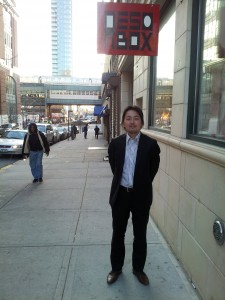
“We don’t want art to be only for wealthy people, but instead want to target as wide an audience as possible for the purpose of disseminating Japanese culture. This is actually the reason why we chose to be located in Queens, as it is said to be the most diverse part of the city.” (Stacy Smith)
By Stacy Smith (Kumamoto-ken CIR, 2000-03) for JQ magazine. Stacy is a professional Japanese writer/interpreter/translator. She starts her day by watching Fujisankei’s newscast in Japanese, and shares some of the interesting tidbits and trends together with her own observations in the periodic series WITLife.
In recent years, Long Island City has experienced a rapid gentrification, being converted from an abandoned, industrial wasteland to a hotspot of waterfront apartments and art institutions. Of course it has big hitters like the Noguchi Museum that are well known to Japanophiles, but there are also Japan-related galleries flying under the radar just waiting to be discovered. One such place is Resobox, a short walk from the Queensboro Plaza subway stop whose location is marked by only a small, overhanging sign and a signboard that sits on the sidewalk reading: “The place where people who are conversant with, dedicated to and influenced by Japanese art can gather, create innovative arts through the collaborative process and disseminate them to the world.” Interest piqued? So was mine, and I was fortunate to have the opportunity to speak with Resobox co-owner Takashi Ikezawa to learn more about this unique endeavor.
Can you share with JQ readers Resobox’s back story and the origin of your name?
Resobox was a name created from the words “resonate” and “box,” and it refers to a space where artists can meet and collaborate to create new and innovative art. It initially referred to a project begun by my partner Fumio Tashiro, a jazz musician who became interested in experimental music and music as art performance. He would collaborate with dancers, painters, and musicians to put together performances. I had a business background as I worked at a talent agency representing Japanese artists in NYC, and I knew Fumio casually. However, we started meeting up monthly to brainstorm, and our discussions always focused on the breadth and depth of Japanese culture and arts. In order for a solid collaboration to take place, you need to have a strong foundation. Since we are both Japanese, we found the culture of our native country to be a foundation substantial enough to build on. Our brainstorming sessions yielded the idea of artists, both Japanese and non-Japanese, coming to our box and resonating off each other to create new Japanese art. This is how Resobox was launched in its gallery form in June of 2011.
Can you give an example of some successful collaborations?
One of the artists who was featured until early January, Mary Burton Wheeler, became involved by taking a Japanese ink painting (sumi-e) class at Resobox. It happened to be taught by Ayakoh Furukawa, the artist we currently have on display, and collaboration began in this class environment. Wheeler learned not just about Japanese painting itself but about Japanese sense and ideas, and she incorporated this into the new pottery she produced as a result. On first glance you wouldn’t say that her work is particularly “Japanese,” but on closer look there is definitely a Japanese sensibility that she encountered via her collaboration with Ayakoh.
Justin’s Japan: Nippon in New York – A Lunar New Year Kickoff

Wakamaru, left, and Hiroshi Ota star in the short play “I, Worker,” part of the Seinendan Theater Company + Osaka University Robot Theater Project at Japan Society Feb. 7-9. (Osaka University & Eager Co. Ltd.)
By JQ magazine editor Justin Tedaldi (CIR Kobe-shi, 2001-02) for Examiner.com. Visit his Japanese culture page here for related stories.Saturday, Feb. 2, 6 p.m.-10 p.m.Stay warm this winter with some hot local events, from retro anime screenings to bilingual robot plays to a J-pop infused Lunar New Year spectacular.
This month’s highlights include:
Feb. 1-15, 9:30 a.m.-4:00 p.m.
NIPPON-JIN Exhibition
Consulate General of Japan, 299 Park Avenue
Free
Presented by J-COLLABO, a unique social network that promotes the Japanese art scene with various collaborating artists, NIPPON-JIN (meaning “Japanese”), will be on view at the gallery of the Consulate General of Japan from Feb. 1-15. Showcasing more than 300 unique portrait photographs taken by Junichi Takahashi, NIPPON-JIN reveals what Takahashi sees as “Japanese people,” opposed to the prototype of stereotypical “Japanese” that others expect and portray. To capture the essence of what makes Japanese “Japanese,” Takahashi decided to approach this project by taking hundreds of samples over a four-year period of Japanese being themselves, letting the accumulation of the subject matter form the answer. The exhibition will go to the gallery of Narita International Airport in Japan this summer.
Sunday, Feb. 3, 3:00 p.m.-4:00 p.m.
Salon Series No. 44. Gestures, Mime and Dance
Tenri Cultural Institute, 43A West 13th Street
$15 general, $10 students/seniors
Now in its fifteenth year, the 45th performance of Sachiyo Ito & Company’s Salon Series is titled “Gestures in Japanese Dance and Mime.” From noh theater to today’s baseball heroes, the Japanese have tended to use more gestures than other peoples, particularly compared to those in the west, and in much subtle manner. Why and how we use them in daily life and see any of those are reflected in dance. Featuring guest Yass Hakoshima (who led Yass Hakoshima Movement Theater for 40 years in the USA and Europe), live demonstrations will illustrate how a mime draws gestures from daily life as a comparison and to gain further insight. Excerpts from kabuki dances choreographed by Ito as well as Hakoshima’s ever-popular comic piece, “Fisherman,” will be performed.
Feb. 7-9, 7:30 p.m.
Seinendan Theater Company + Osaka University Robot Theater Project
Japan Society, 333 East 47th Street
$28, $25 Japan Society members
Imagine a time when “robot maids” are commonly found in family households. That’s the much-anticipated setting of these two heartrending short plays by Oriza Hirata, founder of Japan’s celebrated Seinendan Theater Company. In Sayonara (android and human actors), an android is bought to console a girl suffering from a fatal illness, but when its mechanics go awry, the meaning of life and death to humans and robots comes into question. In I, Worker (robots and human actors), a husband’s struggle to cope with the loss of his child is juxtaposed with the malaise of one of his robots, which has lost all motivation to work. This double bill was developed in collaboration with Dr. Hiroshi Ishiguro, a leading international researcher on robotics and Director of the Intelligent Robotics Laboratory at Osaka University. Sayonara will be performed in English and Japanese with English subtitles. I, Worker will be performed in Japanese with English subtitles.
For the complete story, click here.
Job: Open City Magazine Editor
Via The Asian American Writers’ Workshop. Posted by Kay Monroe (Miyazaki-shi, 1995 -97). Click here to join the JETwit Jobs Google Group and receive job listings even sooner by email.
————————————————————————————————————
Position: Editor for Open City Magazine
Posted by: The Asian American Writers’ Workshop
Type: Part- or full-time position with benefits
Location: New York
Salary: N/A
Start Date: N/A
Company Overview:
The Asian American Writers’ Workshop is looking to hire an editor for Open City (http://opencitymag.com ), our magazine of Asian American New York that’s been covered in the Wall Street Journal and NPR.
Open City, an online magazine published by the Asian American Writers’ Workshop, documents the pulse of metropolitan Asian America as it’s being lived on the streets right now. We’re looking for a self-motivated and resourceful editor with a vibrant vision of how the stories of immigrant New York City should be told. Here’s an opportunity to lead a smart publication about issues you actually care about—and that you actually want to read. As editor, you will assign, edit, develop, and produce content on the multi-ethnic Asian neighborhoods that now comprise one million New Yorkers. Read More
CLAIR Magazine “JET Plaza” series: Matthew Fuller (Aichi)
Each month, current and former JET participants are featured in the “JET Plaza” section of the CLAIR Forum magazine. The December 2011 edition includes an article by JET alumn Matthew Fuller. Posted by Celine Castex (Chiba-ken, 2006-11), currently programme coordinator at CLAIR Tokyo.
***********
旧友との再会2010_1.jpg)
“Often, you are the only foreigner that people will ever get to know, and so you are truly an Ambassador to Japan from the outside world – and that’s a powerful platform.”
Matthew Fuller (Aichi-ken, Toyota-shi, 1997-99) is originally from Austin, Texas. He came to Japan on the JET Programme and lived and taught in the rural village of Shimoyama which later merged to be part of Toyota City in Aichi Prefecture. After a master’s degree in Public Affairs from the LBJ School of the University of Texas, he joined the US Department of State. Matthew Gardner Fuller is currently the special assistant to the US Ambassador to Japan John V. Roos in Tokyo where he has served since 2009.
What was one the most positive aspects of your experience on the JET Programme?
One of the best things for me was the lifelong connections I made with the people in my community. What started out as sharing an occasional drink with some people in Shimoyama, ended up growing into long-term friendships. In fact, one of the friends I made during my time on JET has continued to keep in touch with me by calling every month to chat. He even continued to check in on me while I was on assignment in Baghdad. It’s these connections that really made my time on JET special. And these ongoing connections have provided numerous opportunities to go back and visit Shimoyama. For example, I was recently invited to and attended the wedding of a former student. I also had the chance to accompany Ambassador Roos to Shimoyama to help provide a firsthand look at the long-lasting grassroots exchange that the JET Programme is capable of fostering. Read More
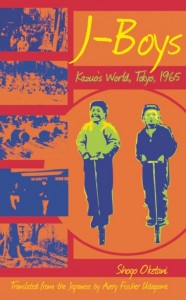
“J-Boys is a historical lesson for readers of all ages. Although the story takes place 20 years after World War II, Japan is still very much scarred by the war and Oketani mentions how it affected the mindsets of the country’s people.” (Stone Bridge Press)
By Rashaad Jorden (Yamagata-ken, 2008-2010) for JQ magazine. Rashaad worked at four elementary schools and three junior high schools on JET, and taught a weekly conversion class in Haguro (his village) to adults. He completed the Tokyo Marathon in 2010, and was also a member of a taiko group in Haguro.
The 1960s were a decade of enormous change around the world. Although Japan didn’t experience the upheaval some other countries did during that period, for one teenager, the mid-1960s were shaping up to be a different era.
Shogo Oketani’s novel J-Boys: Kazuo’s World, Tokyo, 1965 takes readers into the lives of young Kazuo Nakamoto and, to a lesser extent, his friends—younger brother Yasuo, his friend Nobuo, Nobuo’s older brother Haruo, and Kazuo’s classmate Minoru. As steeped in tradition as Japan is (and continues to be), Oketani paints a picture of a society beginning to be seriously touched by foreign influences. Inspired by the 1964 Olympics in their hometown, Kazuo and Haruo usually head to an empty lot after school to emulate 100-meter champion Bob Hayes (It was Kazuo’s dream to be an Olympic sprinter). And like many young people across the world, Haruo went crazy for a quartet from Liverpool, often singing “A Hard Day’s Night.”
Essentially, J-Boys (which was based on Oketani’s childhood)serves a journey through the ups-and-downs of adolescence while introducing younger readers to Japanese culture and the changing landscape of the country. Kazuo’s father speaks about the rise in TV’s popularity with an air of sadness, blaming it for the loss of a nearby cinema. Likewise, Kazuo feels the new Tokyo (much of it fueled by Olympic-related construction) he sees during his Saturday afternoon walks is not necessary an improved one. Kazuo develops a crush on a girl he’s known for quite a while, but sees a couple of close friends move just prior to the start of a new school year. So he realizes he’s about to embark on an unpredictable journey.
CLAIR Magazine “JET Plaza” series: Austin Moore (Yamaguchi)
Each month, current and former JET participants are featured in the “JET Plaza” section of the CLAIR Forum magazine. The January 2013 edition includes an article by Austin Moore, a former Monbusho English Fellow (MEF), the forerunner to the JET Programme. Posted by Celine Castex (Chiba-ken, 2006-11), currently programme coordinator at CLAIR Tokyo.
***********
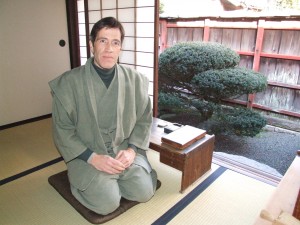
“Sometimes I joke that back when I began what quite unexpectedly is turning out to be a lifetime in Japan, the local men carried swords and wore topknots.”
Austin Moore was born and brought up in a house that was built in 1830 in a small town of Massachusetts. After graduating from Syracuse University in 1984, he came to Japan to work as a member of the Monbusho English Fellow Programme in Yamaguchi Prefecture. Three years later, he moved to Tokyo to join the organization which is today known as CLAIR. Austin has been working for the Japan Intercultural Academy of Municipalities in Shiga Prefecture for the past twenty years. He is also the head of the Historic Preservation Society of Hino town, where he lives in a house that dates back to Edo period.
Adoption Of and By Japan
Sometimes I joke that back when I began what quite unexpectedly is turning out to be a lifetime in Japan, the local men carried swords and wore topknots. While that is more than a small exaggeration, the changes in Japanese society that I have witnessed during these three decades are nearly as significant.
In 1984, immediately after concluding my studies at Eisenhower College and Syracuse University, I was accepted into the Monbusho English Fellow (MEF) Program (preceding JET and run exclusively by the Ministry of Education) and spent almost three years in Yamaguchi Prefecture – the philosophical birthplace of modern-day Japan. There, for the first year, I had the distinction of being the only American employed by the prefectural education board and, as such, visited most every public high school in the prefecture, as well as numerous junior high schools.
It was the very beginning of July when I arrived in Yamaguchi. My supervisor was a kind man who spoke extremely good English – the only one in the office who did. But a week into life as an MEF, my supervisor, my ‘life-support system’, left for a month-long training seminar at Tsukuba University. And so it was that I promptly learned to breathe on my own. Read More
Justin’s Japan: Japan Society Presents 15th Contemporary Dance Showcase: Japan + East Asia
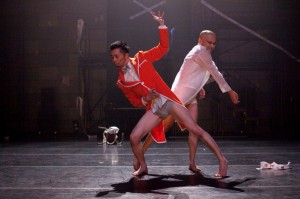
From Tokyo, “Misshitsu: Secret Honey Room,” created and performed collaboratively by Makotocluv founder Makoto Enda (in orange) and former Dairakudakan dancer Kumotaro Mukai (in white), has its North American premiere at Japan Society of New York Jan. 11-12. (Hideto Maezawa)
By JQ magazine editor Justin Tedaldi (CIR Kobe-shi, 2001-02) for Examiner.com. Visit his Japanese culture page here for related stories.
Japan Society swings into the new year with two nights of its upcoming 15th Contemporary Dance Showcase: Japan + East Asia showcase from Jan. 11-12. This year’s program features four North American premieres.
Since the inception of the Performing Arts Program in 1953, Japan Society has introduced more than 600 of Japan’s finest performing arts to an extensive American audience. The program also commissions new works to non-Japanese artists, produces national tours, organizes residency programs for American and Japanese artists and develops and distributes educational programs. Originally America’s leading platform for the introduction of Japanese choreographers and companies, the Dance Showcase has expanded to include artists and works of international acclaim from the broader East Asian region.
From Tokyo comes the U.S. premiere of post-post-post butoh Misshitsu: Secret Honey Room – Duo Version, created and performed collaboratively by Makotocluv founder Makoto Enda and former Dairakudakan dancer Kumotaro Mukai, following a world premiere at Setagaya Public Theatre/Theatre Tram in Tokyo in August 2012. Formed in 2001, Makotocluv appeared at Japan Society in 2008 and was hailed by the New York Times as “wonderfully fluent in the language of the theater.” Misshitsu: Secret Honey Room marks Mukai and Enda’s first collaboration in 15 years.
For the complete story, click here.
JETwit seeks new JETAA Chapter Beat Curator
Posted by Kay Monroe (Miyazaki-shi, 1995 -97). Click here to join the JETwit Jobs Google Group and receive job listings even sooner by email.
————————————————————————————————————
JETwit is seeking a new person to curate the periodic JETAA Chapter Beat posts on the site. If interested, please email me directly at jetwit@jetwit.com. Here’s a link to previous JETAA Chapter Beat posts: http://jetwit.com/wordpress/category/category/category/category/category/category/category/category/category/category/category/category/category/category/category/category/category/category/category/category/category/category/category/category/jetaa-chapter-beat/
The role involves subscribing to as many JETAA chapter email lists/groups as possible. Then once a week (or periodically) putting up a post on JETwit with a small sampling of interesting items that you see. And the goal is to give a sense of what’s going on in the JETAA world. You can be as straightforward or creative as you’d like with the posts. There are also certain strategic elements to the JETAA Chapter Beat posts that I’ll explain when we get to that point.
You’ll be replacing JET alum Jonathan Trace, the first and only JETAA Chapter Beat poster to date. He did a wonderful job for several years, and you’ll have the benefit of his experience via email should you need any help. (I’ll be available to help too, of course.)
Yoroshiku onegaishimasu,
Steven
JQ Magazine: Same-sama, Party of One
By Leah Zoller (CIR Ishikawa-ken, 2009-11) for JQ magazine. Leah lives in Kanazawa, where she works as a writer and web administrator for The Art of Travel. In her spare time, she writes I’ll Make It Myself!, a blog about food culture in Japan and curates The Rice Cooker Chronicles on JETwit.com.
I live and work not too far from Omicho Market, and as a result, I see a lot of “Kanazawa’s Kitchen” and its back alleys in all seasons. I particularly like passing through in winter when the crabs are set outside the fish sellers’ stalls in the morning, the steam rising off their Styrofoam crates like a cloud in the cold air.
According to my coworkers, Omicho Market was once narrow and dirty, the way one expects a fish market to be. Since being renovated, Omicho, with its wide paths, incense to cover up the scent of fish, and ice blocks to relieve the summer heat, really fits with the tone and charm of our little city on the sea. Of course, the site is popular with tourists, but locals—myself included—actually shop there, since the variety and price of produce and seafood is often better than it is at the supermarkets. Every visit there is like a culinary adventure to me: What will be on sale today? Will the price of persimmons have dropped? What new squash varieties are the farms in the Noto growing?
Even Omicho, whose weaving roads I know like the back of my hand, has its surprises. One weekend in early winter (and winter comes early to Kanazawa), my husband and I were walking past one of the market’s side entrances when something caught my eye. I couldn’t quite process what I was seeing at first—was that a person was lying on the ground in front of one of the restaurants?
The figure on the ground was about my height, but slowly the realization that it wasn’t a person sank in. No, it wasn’t a person at all—it was a dead shark.
JQ Magazine: Book Review – ‘Samurai Awakening’

“Ultimately, Samurai Awakening is a fun read that makes you think you’re watching a movie.” (Tuttle)
By Rashaad Jorden (Yamagata-ken, 2008-2010) for JQ magazine. Rashaad worked at four elementary schools and three junior high schools on JET, and taught a weekly conversion class in Haguro (his village) to adults. He completed the Tokyo Marathon in 2010, and was also a member of a taiko group in Haguro.
For those who have lived in Japan, there were probably times when nothing seemed to be going right while struggling to get adjusted to a new culture. But eventually—or maybe miraculously—things take a 180 degree turn.
Well, that happened in Samurai Awakening, Benjamin Martin‘s work of fiction for young adults. Martin—currently a fifth year Okinawa Prefecture JET—tells the story of David Matthews, an exchange student spending the year in Japan. David is frustrated and unhappy due to the fact he can’t speak Japanese well and hasn’t made any close friends. Fittingly, very early in the story, he is bloodied in a fight with students at Nakano Junior High School.
But after attending a local temple ceremony, David learns a new god has created special powers in him. He is now able to speak Japanese fluently, fight incredibly well and turn into a cat. However, those are not the only surprises in the book. His host family the Matsumotos, who are famous sword makers, are also keeping a secret handed down to their ancestors by the Emperor of Japan. And it is with the Matsumotos that he must work to save his host sister Rie, as wolves have taken up residence in her body.
JET Alum Author Beat 12.15.12
Gemma Vidal (Okayama-ken, 2010-12) is a recently returned JET seeking work in licensing/merchandising (if it’s within the publishing industry, even better!). You can usually find her in her little web spaces Gem in the Rough and Peachy Keen (her JET adventures) or training with San Jose Taiko. If you know of any authors/aspiring writers you’d like to see featured in JET Alum Author Beat, just contact Gemma at gem.vidal [at] gmail.com. She would also like to express her deepest condolences to the community of Newtown, Connecticut.
- Roland Kelts (Osaka-shi, 1998-99), author of Japanamerica wrote a special article for The Japan Times where he interviewed Pete Townshend, guitarist of The Who and discussed UK/Japan post-WWII similarities and Mr. Townshend’s recent memoir, “Who I Am”. You can find the article here. Roland Kelts also posted an interesting article on the possible decline of the pop culture phenomenon “Japan Cool”. That article can be found here at The Christian Science Monitor.
- If you’re looking for some light entertainment, Young Adult book Guardian of the Dead’s New Zealand author Karen Healey self-published a collection of essays titled Teen Movie Times. In this collection she muses on teen movie “classics” such as Bring it On and Clueless. Who knows, maybe one of these movies can be used in one of your lessons?
JQ Magazine: Book Reviews – ‘Belka, Why Don’t You Bark?’ and ‘The Future Is Japanese’
A pair of this year’s releases from Haikasoru.
Belka, Why Don’t You Bark?
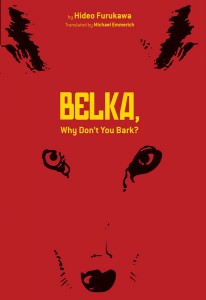
“As a writer, Furukawa is possessed of a kinetic voice that seems to teeter on the edge of insanity. The hyperactive prose is sometimes poetic, sometimes sharp like a stinging slap in the face. Often, it’s both.” (Haikasoru)
By Sharona Moskowitz (Fukuoka-ken, 2000-01) for JQ magazine. Sharona is interested in fresh, new voices in fiction and creative nonfiction.
War: It’s a Dog’s Life. Battle Is a Bitch. War and Fleas.
These were just a few of the potential titles I had streaming through my mind as I sat down to write the review of Belka, Why Don’t you Bark?, the newly translated novel by Hideo Furukawa. But the truth is, love it or hate it (and you very well may hate it, but more on that later), Belka is far too original to be reduced to silly catchphrases or bromides.
At the very start of the novel, readers are met with a detailed canine family tree complete with the dogs’ names and nationalities. In looking back, this might as well have been a de facto warning: if anthropomorphism is not your thing, put this book down immediately.
The story begins in 1943 on the Aleutian Island of Kiska where four military dogs are left by the Japanese and then claimed by U.S. troops after the Japanese retreat. One dog dies and the other three go on to produce the offspring that populate the novel and occupy the branches of the family tree. Belka chronicles the lives of the military dogs who trace their roots back to Kiska, intertwined with the story of the young daughter of a yakuza boss who is kidnapped in the USSR and has a psychic connection to dogs. Belka is a book about history through canine eyes, namely the wars of the 20th century, as Furukawa tells us “history is moved, rolled this way and that, so simply. The twentieth century was a pawn, as were the dogs.”



